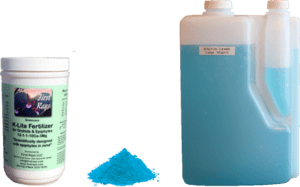
In forums, Facebook, and the like, the question of fertilizer stability often comes up, so this article will hopefully put a few minds at ease.
Dry fertilizer powders tend to be made up of inorganic mineral salts that are quite chemically stable. Usually, the only organic ingredient is iron-EDTA, but it is quite stable as well. Kept in an air-tight container, your powdered or granular fertilizer can be good for years.
The powders tend to be quite hygroscopic, so if humidity is permitted to enter the container, it will become a “sludge”, but may still be viable for use. If the formula contains calcium and magnesium, those minerals may react and become insoluble, but it takes a fair amount of moisture and time for that to happen. You won’t be able to measure it by weight, but volumetric estimates will still be close.
The color of the powder is likely to change as it absorbs moisture – the indicator dyes are pH sensitive – but that has absolutely no impact on the quality of the fertilizer.
I am a big proponent of making fertilizer concentrate solutions for dispensing. In addition to making measurement easier, it ensures that the dispensed formula is pretty constant, especially with specialty formulas that can be quite heterogeneous as a dry blend. That begs the question about the stability of those stock solutions. There are two factors to consider – the concentration and the storage.
Most water-soluble fertilizer powders have a solubility limit of about two pounds per gallon, but from a practical standpoint, especially for formulas containing calcium and magnesium, it should be diluted far more than that to avoid precipitation. For example, I use a Bettix bottle, like that pictured above, to make two quarts of solution that can be dispensed at a rate of one ounce per gallon to make a 100 ppm N final solution. I add 50 grams (about 1/9th of a pound) to the bottle and fill to two quarts volume. That is a stable solution that lasts me about 3 months between refills. Storage of that dilute solution is another factor to consider.
Containers of dilute fertilizer solutions should be kept sealed and out of sunlight. Keeping it sealed prevents the water from evaporating, and minimizes the risk of fungal or bacterial growth in the solution. Keeping it in the dark, or at least away from direct light, reduces the likelihood of UV degradation of the trace elements.
Organic additives like Kelpak and Quantum-Total should be stored in their concentrated forms, keeping them cool and dark. When you dilute them for use, it is best to only dispense what you’ll use immediately, as they can degrade relatively quickly once diluted – if I have extra, I use it no later than the next day.